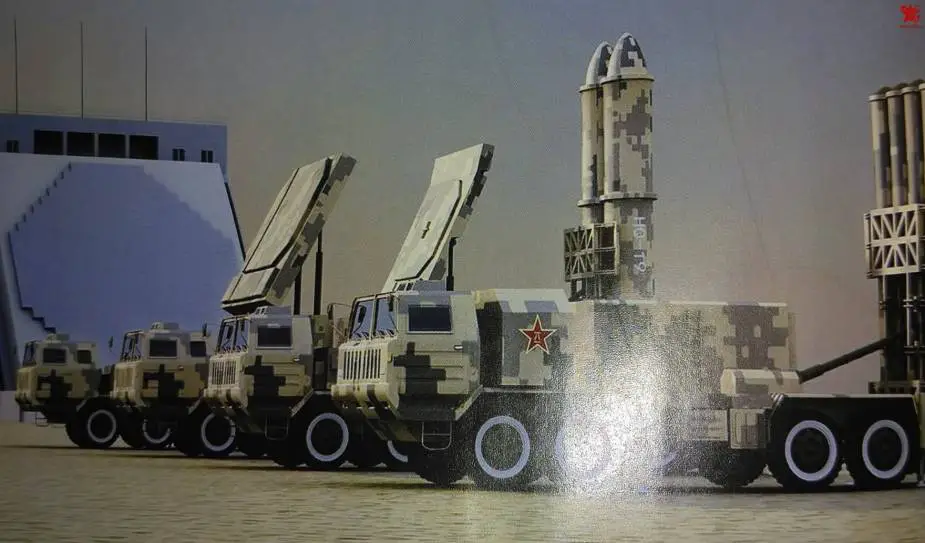A vastly upgraded version of HQ-9 to counter ballistic missile and satellites (ASAT) on the lower end of Low Earth orbits, HQ-19 is the Chinese equivalent of the U.S. THAAD. HQ-19 is armed with a dual-purpose exosphere kinetic kill vehicle (kkv) warhead designed by a team led by Professor Zhou Jun, which can be used against ballistic missile warheads or satellites. Using its HQ-19 Anti-Ballistic Missile Interceptor, China carried out a 4th land-based mid-course missile interception test within its territory on 5 February 2018 and "achieved the desired test objective". As usual, the government announced that the "test is defensive in nature and not targeted against any country".
Follow Army Recognition on Google News at this link

HQ-19 is an Anti-Ballistic Missile Interceptor that includes a solid phased array radar for early warning. It is reported that the X band phased array radar can detect targets at a distance of 4,000 km (Picture source: Chinese media)
The Chinese HQ-19 missile is a project launched in the late 1990s. In 1995 the Chinese started serious studies of a kinetic kill vehicle KKV under Program 863, Global Security reports. In 1986, to meet the global challenges of the new technology revolution and competition, four Chinese scientists jointly proposed to accelerate China’s high-tech development. With strategic vision and resolution, the late Chinese leader Deng Xiaoping personally approved the National High-tech R&D Program, namely the 863 Program. Implemented during three successive Five-year Plans, the program has boosted China’s overall high-tech development, R&D capacity, socio-economic development, and national security. In April 2001, the Chinese State Council approved the continued implementation of the program in the 10th Five-year Plan. As one of the national S&T program trilogy in the 10th Five-year Plan, 863 Program continues to play its important role.
In 1999, the first Chinese KKV made the suspension tests successfully flight, China became the second country in the world to have mastered the technology. The first test of V & V was held in 2003 with success. It was in final certification. HQ-19 has a KKV of about 35kg, the system performance would be similar to the U.S. THAAD. Another R & D document mentions a technology demonstration at the HQ-19 engines in 2000, led by the Academy 4 CCAC group. The demonstration also validated "hull carbon fiber" and "rocket N-15B".
The HQ-9B, HQ-19 [THAAD counterpart], HQ-26 [SM-3 counterpart] and HQ-29 [PAC-3 counterpart] are designed primarily for Anti Ballistic Missile capabilities. While the HQ-9A air defense variant of the HQ-9 series is very well attested, the remaining theater missile defense interceptors are poorly attested, and verge on being little more than rumors.
The Red Flag-19 system also includes a multi-purpose solid phased array radar for early warning. It is reported that the X band phased array radar can detect targets at a distance of 4,000 km, covering the northern fringe of the South Asian subcontinent to the vast areas of the hinterland of the Qinghai-Tibet Plateau. The information is provided to the Red Flag-19 interception system via the command-and-control system.
During the 2013 and 2014 interception tests, the Red Flag-19 missile successfully reproduced the situation of USA Standard 3 intercepting the USA-193 at that time. At a height of over 200 km, it approached a relative speed of 10,000 m / Intercept simulation of intercontinental missiles hit the target.
According to another judgment, the red flag -19 kinetic energy interceptor uses a side-window infrared seeker similar to U.S. THAAD's one. The window design can reduce the impact of atmospheric friction and heat on the infrared sensor detection, giving the missile the interception capability in the atmosphere. Side-window infrared seeker gives the red flag -19 in the atmosphere a high attack accuracy and can use a lighter kinetic energy interceptor to increase the interceptor's shot height and range.















